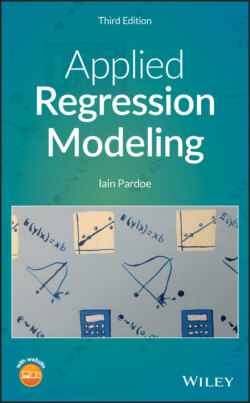Applied Regression Modeling

Реклама. ООО «ЛитРес», ИНН: 7719571260.
Оглавление
Iain Pardoe. Applied Regression Modeling
Table of Contents
List of Tables
List of Illustrations
Guide
Pages
Applied Regression Modeling
Copyright
Preface
Acknowledgments
INTRODUCTION. I.1 STATISTICS IN PRACTICE
I.2 Learning Statistics
About the Companion Website
Chapter 1 Foundations
1.1 Identifying and Summarizing Data
1.2 Population Distributions
1.3 Selecting Individuals at Random—Probability
1.4 Random Sampling
1.4.1 Central limit theorem—normal version
1.4.2 Central limit theorem—t‐version
1.5 Interval Estimation
1.6 Hypothesis Testing
1.6.1 The rejection region method
1.6.2 The p‐value method
1.6.3 Hypothesis test errors
1.7 Random Errors and Prediction
1.8 Chapter Summary
Problems
Chapter 2 Simple Linear Regression
2.1 PROBABILITY MODEL FOR and
2.2 Least Squares Criterion
2.3 Model Evaluation
2.3.1 Regression standard error
2.3.2 Coefficient of determination—
Correlation
2.3.3 Slope parameter
Slope hypothesis test
Slope confidence interval
2.4 Model Assumptions
2.4.1 Checking the model assumptions
2.4.2 Testing the model assumptions
2.5 Model Interpretation
2.6 Estimation and Prediction
2.6.1 Confidence interval for the population mean, E
2.6.2 Prediction interval for an individual ‐value
2.7 Chapter Summary
2.7.1 Review example
Problems
Chapter 3 Multiple Linear Regression
3.1 Probability Model for (X1, X2, …) and Y
3.2 Least Squares Criterion
Optional—formula for regression parameter estimates
3.3 Model Evaluation
3.3.1 Regression standard error
3.3.2 Coefficient of determination—
Adjusted
Multiple correlation
3.3.3 Regression parameters—global usefulness test
3.3.4 Regression parameters—nested model test
3.3.5 Regression parameters—individual tests
Regression parameter hypothesis tests
Regression parameter confidence intervals
Correlation revisited
Predictor selection
Optional—formula for regression parameter standard errors
3.4 Model Assumptions
3.4.1 Checking the model assumptions
3.4.2 Testing the model assumptions
3.5 Model Interpretation
3.6 Estimation and Prediction
3.6.1 Confidence interval for the population mean, E
3.6.2 Prediction interval for an individual ‐value
Optional—formulas for standard errors of estimation and prediction
3.7 Chapter Summary
Problems
Chapter 4 Regression Model Building I
4.1 Transformations
4.1.1 Natural logarithm transformation for predictors
4.1.2 Polynomial transformation for predictors
Optional—mathematical justification for preserving hierarchy when using polynomial transformations
4.1.3 Reciprocal transformation for predictors
4.1.4 Natural logarithm transformation for the response
4.1.5 Transformations for the response and predictors
Optional—regression parameter interpretations for transformed predictors
4.2 Interactions
4.3 Qualitative Predictors
4.3.1 Qualitative predictors with two levels
4.3.2 Qualitative predictors with three or more levels
Optional—testing equality of regression parameters with the nested model test
4.4 Chapter Summary
Problems
Chapter 5 Regression Model Building II
5.1 Influential Points
5.1.1 Outliers
Optional—formulas for standardized and studentized residuals
5.1.2 Leverage
Optional—formula for leverages
5.1.3 Cook's distance
Optional—formula for Cook's distances
5.2 Regression Pitfalls
5.2.1 Nonconstant variance
5.2.2 Autocorrelation
5.2.3 Multicollinearity
Optional—formula for variance inflation factors
5.2.4 Excluding important predictor variables
5.2.5 Overfitting
5.2.6 Extrapolation
5.2.7 Missing data
5.2.8 Power and sample size
5.3 Model Building Guidelines
5.4 Model Selection
5.5 Model Interpretation Using Graphics
5.6 Chapter Summary
Problems
Bibliography
Glossary
Index
WILEY END USER LICENSE AGREEMENT
Отрывок из книги
Third Edition
Iain Pardoe Thompson Rivers University The Pennsylvania State University
.....
Under very general conditions, t has an approximate t‐distribution with degrees of freedom. The two differences from the normal version of the central limit theorem that we used before are that the repeated sample standard deviations, , replace an assumed population standard deviation, , and that the resulting sampling distribution is a t‐distribution (not a normal distribution).
To illustrate, let us repeat the calculations from Section 1.4.1 based on an assumed population mean, , but rather than using an assumed population standard deviation, , we will instead use our observed sample standard deviation, 53.8656 for . To find the 90th percentile of the sampling distribution of the mean sale price, :
.....